Plant
Doctor Archive

Bugs
on my veggies
 I
have green vegetable bugs and spider mites on my beans. How can
I control them? I
have green vegetable bugs and spider mites on my beans. How can
I control them?
 Green
vegetable bugs will suck the living daylights out of your leaves
and developing beans, causing them to shrivel up. How do we control
this bug? In order to know that, it is good to know its life cycle. Green
vegetable bugs will suck the living daylights out of your leaves
and developing beans, causing them to shrivel up. How do we control
this bug? In order to know that, it is good to know its life cycle.
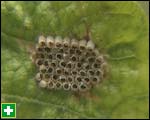 If we start to look at the life cycle, we might as well start
at the top with the eggs.
If we start to look at the life cycle, we might as well start
at the top with the eggs.
The eggs are laid in
batches of a couple of dozen. If you look carefully, you'll see
they're hexagonal in shape.
They've got a flip-top
head, and out come the first tiny wee grubs.
The grubs that come out
of the egg are almost totally black. They're very small, but they'll
soon grow, shed their skin and show a few white dots on their body.
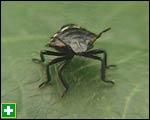 Then they shed their skin again and become even bigger, showing
some yellow spots on the body.
Then they shed their skin again and become even bigger, showing
some yellow spots on the body.
After a few moults, they
slowly become greener and greener, with red patches, black patches
and white patches.
When they shed their
skin a few more times, they arrive at the adult stage — the
green vegetable bug with wings, just as we know it.
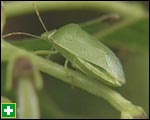 How do we control them? First of all, you can throw any insecticide
at them and it will kill them. If you want to go organic, you could
use pyrethrum, but here is my trick — a really clever one.
How do we control them? First of all, you can throw any insecticide
at them and it will kill them. If you want to go organic, you could
use pyrethrum, but here is my trick — a really clever one.
Use their smell. If you
squash one of those bugs, it emits this pungent odour which not
only wards off predators, but also warns the others in the plant
there is a predator at large.
What all the other green
vegetable bugs do, is they drop down to the ground and play possum,
and think, 'I hope he doesn't see me.'
When you see them all
drop on to the ground, you squash them as well, making more smell,
making more green vegetable bugs drop off, and basically in no time
you've got about 85% of the whole population squashed on the ground.
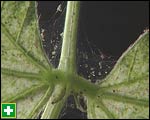 The next bean pest is certainly not as messy. It's the two-spotted
spider mite. You can always tell a leaf damaged by a two-spotted
spider mite. Just look at it — totally white-spotted, stippled,
and blotched. If you turn it over you can see a lot of webbing,
especially if you've got good eyesight or a hand lens.
The next bean pest is certainly not as messy. It's the two-spotted
spider mite. You can always tell a leaf damaged by a two-spotted
spider mite. Just look at it — totally white-spotted, stippled,
and blotched. If you turn it over you can see a lot of webbing,
especially if you've got good eyesight or a hand lens.
On that webbing walk
minute little two-spotted spider mites. They scrape the surface
of the cells on the leaf's underside and suck out the juices, causing
the spotting.
Spider mites have got
one little weakness — they hate cold, wet feet. They love the
warmth. Here's a tip. If you want to control spider mite or stop
them from establishing on your leaves, mist them on the underside
with water every other night or so, making the environment damp
and cold, and the spider mites really hate that.
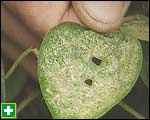 Of course, you can use miticides and things like that, but I
don't go for that.
Of course, you can use miticides and things like that, but I
don't go for that.
But, hey, I've got some
good news for us gardeners. For a while now a company called Zonda,
in Hawke's Bay, are selling predatory mites that feed on the spider
mites. They send them out in packets. What you get are packets of
bean leaves with the same mite damage on it, but full of predators.
You literally hang these
leaves onto your plants. You can attach them with a paper clip.
What happens is the predators will go out hunting for their prey
and feed on your pests. Simple as that. You let the predators do
the work.
Where can you get them?
From Zonda, Switched on Gardener, Veg Gro, Fruitfed, and even Parva
Plants.
Ruud Kleinpaste
 Advice
by Dr Dan Blanchon from Unitec's Diploma in Sustainable Horticulture and Bachelor
of Resource Management. Advice
by Dr Dan Blanchon from Unitec's Diploma in Sustainable Horticulture and Bachelor
of Resource Management.
Reproduced
with permission from NZOOM Home and Garden content,
from the previous
website of 
The views expressed here are not necessarily those of the RNZIH
 |
|
HOME
AND GARDEN
|
|
|
|